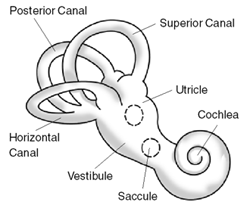Meniere Disease

Description
Meniere disease is a chronic illness characterized by intermittent episodes of vertigo lasting from minutes to hours, with fluctuating sensorineural hearing loss, tinnitus, and aural pressure (Sajjadi and Paparella, 2008).
InheritanceBernstein (1965) reported 7 families with more than 1 case of episodic vertigo and hearing loss. In 1 family identical female twins and the daughter of one of the twins were affected. Three families also had migraine in certain members.
In a review of 500 patients with Meniere disease, Paparella (1985) detected a 20% incidence of positive family history and suggested multifactorial etiology.
In an exhaustive search for families with Meniere disease, Morrison (1995) identified 41 parent-child pairs with a mean 17.5-year difference in age at onset, favoring anticipation.
In a population-based survey of 1,245 Spanish and Italian patients with Meniere disease, Requena et al. (2014) found that 431 (34%) reported a family history of hearing loss or recurrent vertigo, including 133 with possible Meniere disease. However, clinical reevaluation indicated definite Meniere disease in 93 relatives of 76 families. The data indicated that familial Meniere disease occurs in about 8% of patients. Three pairs of monozygotic twins were concordant for the disorder. Estimates of familial aggregation suggested that the disorder is 16 to 48 times more common in sibs and 4 to 12 times more common in offspring of affected individuals compared to the general population. The transmission in most families was consistent with autosomal dominant inheritance and incomplete penetrance. The findings were consistent with a genetic predisposition for the development of Meniere disease.
Molecular GeneticsAssociations Pending Confirmation
By whole-exome sequencing of a Spanish grandmother, mother, and daughter with Meniere disease, Requena et al. (2015) identified 2 novel heterozygous variants, one in the DTNA gene (601239) and the other in the FAM136A gene (616275); all 3 patients carried both variants. The V715F change in the DTNA gene resulted in a splice site alteration with the skipping of exon 21 and production of a shorter alternative transcript, and the Q76X truncating variant in the FAM136A gene resulted in a significant decrease in transcript levels of FAM136A in patient cells. Neither variant was found in the 1000 Genomes Project or Exome Variant Server databases, or in an in-house exome database of 1,000 cases of Meniere disease and 500 controls. Requena et al. (2015) postulated that the variation in these 2 genes contributed to the multifactorial etiology of Meniere disease in this family. Immunohistochemical studies showed that the Fam136a and Dtna proteins are expressed in the sensorineural epithelium of the crista ampullaris in the rat.
In a Spanish family in which a man and his paternal uncle had Meniere disease, and the man's father exhibited an otosclerosis-like phenotype, Martin-Sierra et al. (2016) performed whole-exome sequencing and identified a heterozygous missense variant (c.275G-T; G92V) in exon 3 of the PRKCB gene (176970) in all 3 individuals. The mutation was not found in 2 family members who had episodic vestibular symptoms but no hearing loss. The proband had bilateral progressive hearing loss and tinnitus, whereas his affected uncle had unilateral hearing loss and intractable vertigo, for which he underwent labyrinthectomy. The authors concluded that PRKCB-related Meniere disease shows incomplete penetrance, and that additional genetic, epigenetic, or environmental factors were likely to have contributed to the vestibular phenotype in this family.
Exclusion Studies
Sanchez et al. (2004) found no differences in the nucleotide sequence of exons 4 and 5 of the COCH gene (603196) in 30 patients with definite Meniere disease compared to 30 controls; see DFNA9 (601369).